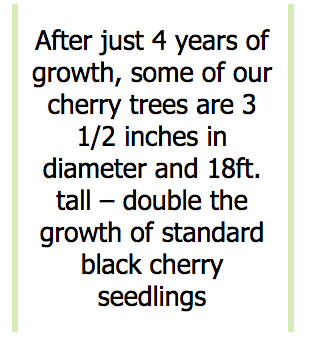Black Cherry Trees
Questions & Answers from Timber Tree Experts
1. What are genetically superior black cherry trees?

These trees are the result of selecting trees that show superior form and growth rate, and are less likely to possess gum defects. Historically, the best black cherry originates in Pennsylvania and New York. Our trees are from these areas. Scion wood from these genetically superior trees is grafted onto black cherry root stock and then planted in research plots. Superior cultivars are then selected.
2. What are the main differences between the improved seedlings and the grafted trees?
The grafted trees are genetically identical clones of the parent cultivars. The superior seedlings are grown from the seeds of these trees. The seedlings will vary somewhat from their parent trees, but should still be genetically capable of growing faster and straighter than common black cherry seedlings.
3. Are the genetically superior black cherry trees really that much better than common seedlings?
After just 4 years of growth, some of our cherry trees are 3 1/2 inches in diameter and 18ft. tall – double the growth of standard black cherry seedlings Because desirable traits such as growth rate and form are inheritable to some degree, selecting trees that are superior in this regard and then selecting trees by the same criteria from successive generations produces a tree that is superior to common seedlings.
4. Will the genetically superior black cherry trees grow and survive in my area? Black cherry is native from northern Florida to Minnesota and west to Texas, Oklahoma and the Dakotas. It grows well in plant hardiness zones 3B thru 8 where there is fertile, well-drained soil with adequate moisture. Our experience has been that as long as soil, nutrient and water requirements are met, these trees will do well in a very large geographical area.
Black cherry is native from northern Florida to Minnesota and west to Texas, Oklahoma and the Dakotas. It grows well in plant hardiness zones 3B thru 8 where there is fertile, well-drained soil with adequate moisture. Our experience has been that as long as soil, nutrient and water requirements are met, these trees will do well in a very large geographical area.
5. What are gum defects?
This is a common defect in cherry trees. At this point, it is not known what causes the defect. Research has shown possible causes are boring insects, genetics and burning of pastures and forests where cherry are growing. We are closely following research by the U.S. Forest Service and hope to have an answer in the future. Our current selections are coming from areas with a limited amount of gum defects and from trees which show little, if any, gum defects. These areas are also where the highest value cherry trees in the nation have been harvested.
6. Should I consider wind when selecting a site on which to plant black cherry trees?
Yes. Black cherry has a shallow fibrous root system and is somewhat brittle. Therefore, a site that is protected from wind is desirable. The protection could be in the form of an overgrown fence row, a wooded area, or some type of geographical configuration. If you do not have any of these, a windbreak could be planted relatively easily and economically. We recommend windbreaks on all plantations, if possible. We also believe interplanting with poplars can provide excellent wind protection and help to improve the form of the cherry trees.

